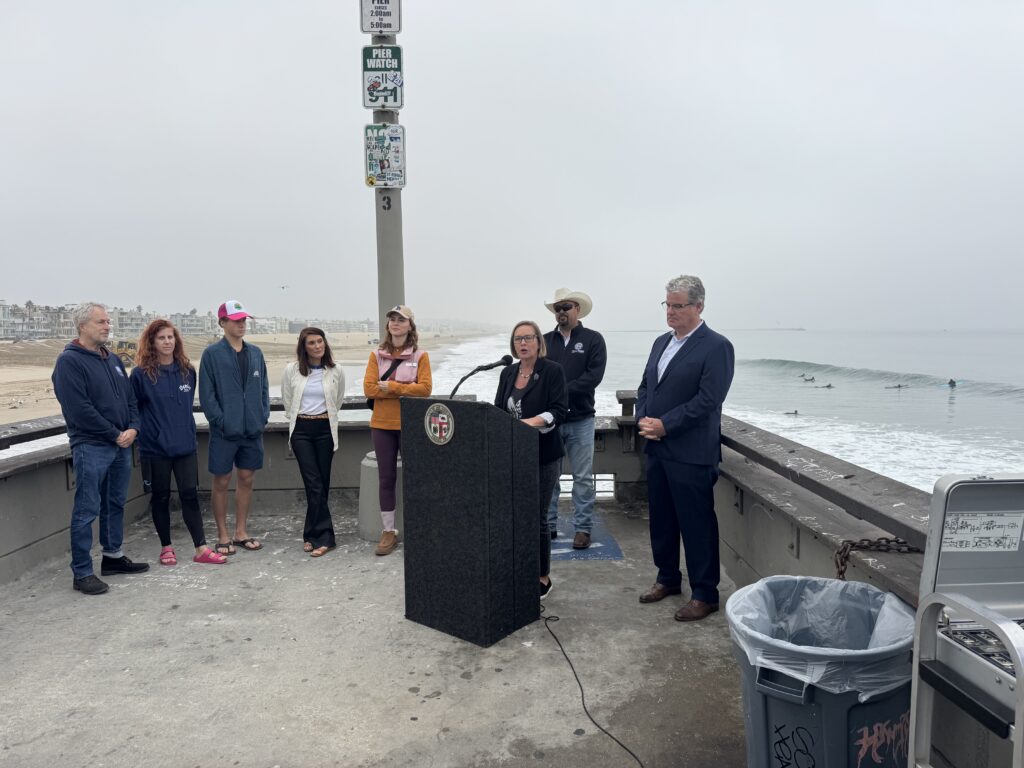
Councilmembers Traci Park (podium) and Tim McOsker were joined by environmental activists and business owners at the Venice Beach Pier.
Councilmember Traci Park stood at a podium overlooking Venice Beach. Surfers below were catching waves as flocks of birds dived and flew over the Pacific Ocean. Fishermen were trying their luck off the pier.
Park, standing with Councilmember Tim McOsker had one message on voting day, November 4, 2025, “Los Angeles will never allow offshore drilling off our coast — not now, not ever,” she said. “The Santa Monica Bay, one of our most cherished national treasures, is not for sale.
“This is about common sense, public safety, and moral responsibility,” Park said. “After the worst wildfire in our city’s history, we know what real loss looks like — and we won’t invite another kind of disaster.”
The Trump Administration is planning to reopen federal offshore oil and gas drilling along California’s coast – the first such plan in decades. The federal Bureau of Ocean Energy Management (BOEM) is reportedly preparing to include California’s coastal waters in a new national leasing program, part of the administration’s goal to expand domestic fossil fuel production. If approved, the plan could mark the first sale of California offshore leases since before the Santa Barbara spill.
McOsker said, “Our coast, our economy, and our children’s futures are too valuable to risk with this foolish federal proposal.”
The Venice Chamber of Commerce warned that any spill would devastate local businesses that rely on tourism, hospitality and recreation. Representatives of the Venice Surfing Association called offshore drilling a direct attack on water quality and public health for the thousands who enter the ocean daily.
The Coastal Alliance emphasized the potential destruction of marine ecosystems and sea life. And the Friends of Ballona Wetlands highlighted how a spill could irreparably harm sensitive wetlands adjoining the coast, where there have been decades of restoration.
The oil-drilling battle goes back to 1966 when Occidental sought to drill in the Palisades area after discovering what the company said was up to 60 million barrels of oil beneath the community. The Los Angeles Basin is a huge underground oil reservoir, with fields found from the Civic Center to Santa Monica Bay and from Beverly Hills to the suburbs of the South Bay.
For nearly 20 years No Oil Inc., a vocal group of Palisades residents and environmentalists fought drilling. No Oil’s first major victory came in 1973 when the California Supreme Court killed the project after being persuaded that it lacked an environmental impact report.
In the November 1988 L.A. City election ballot were two opposing Propositions O and P. Voters narrowly approved Proposition O, which repealed Occidental Petroleum Corporations right to drill in Pacific Palisades.
The City Council and Mayor Tom Bradley in 1985 had granted Occidental authority to drill up to 60 wells on a two-acre site across Pacific Coast Highway from Will Rogers State Beach in Pacific Palisades.
Voters turned down Occidental’s counterinitiative, Proposition P.
Proposition O, co-sponsored by Councilman Zev Yaroslavsky and fellow Councilman Marvin Braude, received 52.3% of the votes cast. Proposition P, promising more money for police and schools, received 34.3%.click here.
On this grey, cool morning along the coast, Park said, “We’re never going to allow off-shore drilling off our coast.”
Along with Councilmembers McOsker and Adrin Nazarian, she co-authored a resolution, which was introduced in the City Council later in the morning, to send a unified message that any federal move to reintroduce offshore drilling would face not only legal challenges, but also strong bipartisan and community opposition from the state’s largest city.
Park said the resolution is not about politics, but about principle. “This is a moment for unity — environmentalists, business owners, and public servants standing shoulder to shoulder to defend what generations of Angelenos fought to protect,” she said. “Los Angeles drew a line in the sand decades ago. Today, we’re drawing it again.”

Following prop o passage by the voters of Los Angeles a “no drilling in perpetuity” document protecting the coastal zone in the city of Los Angeles was filed and accepted by
The city of Los Angeles.
Barbara Kohn
Former CFO and Board Member
No Oil inc
Save the Coast Foundation
barbara@kohn.com
Have fun paying $10/gallon for gas. LOL